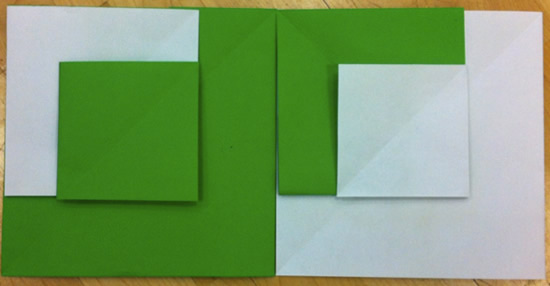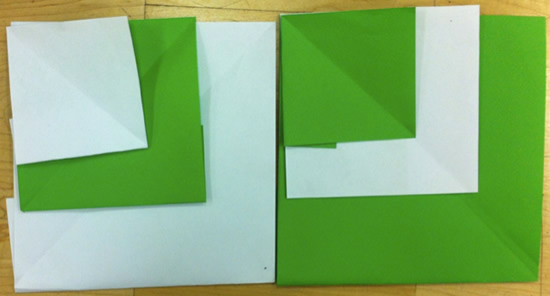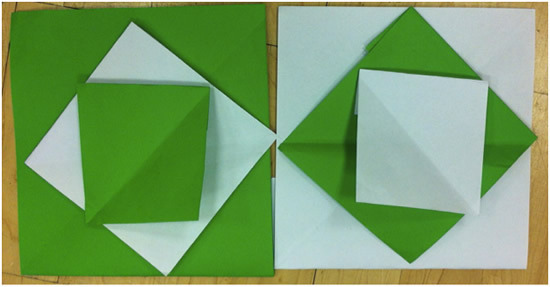Skip over navigation
Below is a picture of an unfolded piece of paper.
Can you work out what shape is made when it's folded along the crease shown on the left-hand side?

Click below if you want to see the shape.

Can you make one of these shapes with a new piece of paper?
Now, make several of the same shape from A4, A5 and A6 pieces of paper in contrasting colours.
Challenge 1
Take a large and small shape made from your first colour and a medium shape made from your second colour.
Make a pattern from your shapes, by laying them on top of each other, that fits both of these rules:
You must be able to see at least part of each shape.
All three shapes must fit inside the perimeter (outline) of the largest shape.
Challenge 2
Use a new large, medium and small shape to recreate the same pattern but in opposite colours from Challenge 1.
Place these two patterns next to each other and begin to make a 'Paper Patchwork' out of the patterns on your classroom floor.
Can you make each of the new patterns a different design from any of the others?
We would love to see photos of the patchwork patterns you have made!
If you enjoyed these challenges, why not have a go at Paper Patchwork 2?
This problem provides the opportunity to develop visualisation skills. It requires children to solve the conundrum of what happens in between, when they are given a picture of a crease pattern and the finally-folded shape.
Just share/project/show the picture of the crease pattern first and allow children to talk about what shape they think it might make when re-folded.
Then share the picture of the ready folded shape (or a real one you made earlier!) and ask children to talk about what they think now.
Give each pair of children a piece of A-sized paper (A4 is easier for smaller hands or beginner folders, but any A size will work) and ask them to try and recreate the shape. They can of course un-do their folds at any point in order to check whether their crease pattern matches the one in the picture.
Here are some patterns made by a school in response to Challenge 2, which you may wish to share with your children (although you may prefer not to steer them):




What do you notice about the different types of fold on the crease pattern?
What order do you think the folds were made in?
How could we check what we've done so far?
Pairs given one piece of A-sized paper could take it in turns to give an instruction whilst their partner carries out the fold. The instructor must do this with their hands on their hand, (no handling of the paper or pointing is allowed) in order to develop the accuracy of their descriptive and positional language. Children might be given larger A-sized paper (A3 for example) to act
as a model for the rest of the class, as folding with larger paper is more difficult and requires more accuracy.
Some children might enjoy trying Paper Patchwork 2.
Give children a piece of paper each to work with in order to allow them to practise their motor skills more independently. Then ask them to compare what they're doing with their partner and to compare shapes for accuracy when they have completed the shape.

Or search by topic
Number and algebra
Geometry and measure
Probability and statistics
Working mathematically
Advanced mathematics
For younger learners
Paper Patchwork 1
Age 5 to 7
Challenge Level 





- Problem
- Getting Started
- Student Solutions
- Teachers' Resources
Paper Patchwork 1
Below is a picture of an unfolded piece of paper.
Can you work out what shape is made when it's folded along the crease shown on the left-hand side?

Click below if you want to see the shape.

Can you make one of these shapes with a new piece of paper?
Now, make several of the same shape from A4, A5 and A6 pieces of paper in contrasting colours.
Challenge 1
Take a large and small shape made from your first colour and a medium shape made from your second colour.
Make a pattern from your shapes, by laying them on top of each other, that fits both of these rules:
You must be able to see at least part of each shape.
All three shapes must fit inside the perimeter (outline) of the largest shape.
Challenge 2
Use a new large, medium and small shape to recreate the same pattern but in opposite colours from Challenge 1.
Place these two patterns next to each other and begin to make a 'Paper Patchwork' out of the patterns on your classroom floor.
Can you make each of the new patterns a different design from any of the others?
We would love to see photos of the patchwork patterns you have made!
If you enjoyed these challenges, why not have a go at Paper Patchwork 2?
Why do this problem?
This problem provides the opportunity to develop visualisation skills. It requires children to solve the conundrum of what happens in between, when they are given a picture of a crease pattern and the finally-folded shape.
Possible approach
Just share/project/show the picture of the crease pattern first and allow children to talk about what shape they think it might make when re-folded.Then share the picture of the ready folded shape (or a real one you made earlier!) and ask children to talk about what they think now.
Give each pair of children a piece of A-sized paper (A4 is easier for smaller hands or beginner folders, but any A size will work) and ask them to try and recreate the shape. They can of course un-do their folds at any point in order to check whether their crease pattern matches the one in the picture.
Here are some patterns made by a school in response to Challenge 2, which you may wish to share with your children (although you may prefer not to steer them):




Key questions
What do you notice about the different types of fold on the crease pattern?What order do you think the folds were made in?
How could we check what we've done so far?
Possible extension
Pairs given one piece of A-sized paper could take it in turns to give an instruction whilst their partner carries out the fold. The instructor must do this with their hands on their hand, (no handling of the paper or pointing is allowed) in order to develop the accuracy of their descriptive and positional language. Children might be given larger A-sized paper (A3 for example) to act
as a model for the rest of the class, as folding with larger paper is more difficult and requires more accuracy.Some children might enjoy trying Paper Patchwork 2.
Possible support
Give children a piece of paper each to work with in order to allow them to practise their motor skills more independently. Then ask them to compare what they're doing with their partner and to compare shapes for accuracy when they have completed the shape.You may also like
Let's Investigate Triangles
Vincent and Tara are making triangles with the class construction set. They have a pile of strips of different lengths. How many different triangles can they make?

